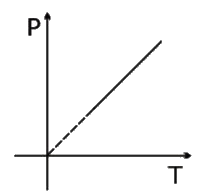If the P-V diagram of a diatomic gas is plotted, it is a straight line passing through the origin. The molar heat capacity of the gas in the process is IR, where I is an integer. Find the value of I.
The correct Answer is:3
To solve the problem, we need to analyze the given information about the diatomic gas and its behavior in a polytropic process. Let's break down the steps:
Step 1: Understand the P-V Diagram
The problem states that the P-V diagram of the diatomic gas is a straight line passing through the origin. This implies that pressure (P) is directly proportional to volume (V). Mathematically, we can express this as:
P=kV
for some constant k.
Step 2: Identify the Type of Process
Since the P-V relationship is linear, we can relate it to a polytropic process where:
PVn=constant
Here, the exponent n can be determined from the linear relationship. For our case, since P is proportional to V, we can conclude that:
n=−1
Step 3: Apply the First Law of Thermodynamics
According to the first law of thermodynamics:
Q=ΔU+W
For a polytropic process, we can express the heat added Q in terms of the heat capacity C:
Q=nCΔT
where C is the molar heat capacity.
Step 4: Relate Internal Energy Change and Work Done
The change in internal energy ΔU for an ideal gas can be expressed as:
ΔU=nCvΔT
where Cv is the molar heat capacity at constant volume.
The work done W in a polytropic process can be expressed as:
W=nRΔT1−n
Substituting n=−1, we get:
W=nRΔT1−(−1)=nRΔT2
Step 5: Substitute Values into the First Law
Now substituting these expressions into the first law equation:
nCΔT=nCvΔT+nRΔT2
Dividing through by nΔT (assuming ΔT≠0):
C=Cv+R2
Step 6: Calculate Molar Heat Capacity for Diatomic Gas
For a diatomic gas, the molar heat capacity at constant volume Cv is given by:
Cv=5R2
Now substituting this into our equation for C:
C=5R2+R2=6R2=3R
Step 7: Identify the Value of I
The problem states that the molar heat capacity is IR. From our calculation, we found:
C=3R
Thus, we can equate:
IR=3R
This gives us:
I=3
Final Answer
The value of I is:
3
The problem states that the P-V diagram of the diatomic gas is a straight line passing through the origin. This implies that pressure (P) is directly proportional to volume (V). Mathematically, we can express this as:
P=kV
for some constant k.
Since the P-V relationship is linear, we can relate it to a polytropic process where:
PVn=constant
Here, the exponent n can be determined from the linear relationship. For our case, since P is proportional to V, we can conclude that:
n=−1
According to the first law of thermodynamics:
Q=ΔU+W
For a polytropic process, we can express the heat added Q in terms of the heat capacity C:
Q=nCΔT
where C is the molar heat capacity.
The change in internal energy ΔU for an ideal gas can be expressed as:
ΔU=nCvΔT
where Cv is the molar heat capacity at constant volume.
W=nRΔT1−n
Substituting n=−1, we get:
W=nRΔT1−(−1)=nRΔT2
Now substituting these expressions into the first law equation:
nCΔT=nCvΔT+nRΔT2
Dividing through by nΔT (assuming ΔT≠0):
C=Cv+R2
For a diatomic gas, the molar heat capacity at constant volume Cv is given by:
Cv=5R2
Now substituting this into our equation for C:
C=5R2+R2=6R2=3R
The problem states that the molar heat capacity is IR. From our calculation, we found:
C=3R
Thus, we can equate:
IR=3R
This gives us:
I=3
The value of I is:
3
Similar Questions
Knowledge Check
- Question 1 - Select One
The molar heat capacity of a gas in a process
Ais either CVorCPBlies between CVorCPCmay range from zero to infinityDcan have any real value - Question 2 - Select One
P-V diagram of a diatomic gas is a straight line passing through origin. The molar heat capacity of the gas in the process will be
A4RB2.5RC3RD4R3 - Question 3 - Select One
P–V diagram of a monatomic gas is a straight line passing through origin. The molar heat capacity of the gas in the process will be:
A3R2BR2C2RD3R
P - V diagram of a diatomic gas is a straight line parallel to P-axis. The molar heat capacity of the gas in the process will be
View SolutionThe molar heat capacity for a gas at constant T and P is
View SolutionThe molar heat capacity for a gas at constant T and P is
View SolutionThe pressure P of an ideal diatomic gas varies with its absolute temperature T as shown in figure. The molar heat capacity of gas during this process is [R is gas constant]
 View Solution
View SolutionIn a thermodynamic process on an ideal diatomic gas, work done by the gas is η times. The heat supplied (η<1). The molar heat capacity of the gas for the process is
View Solution

